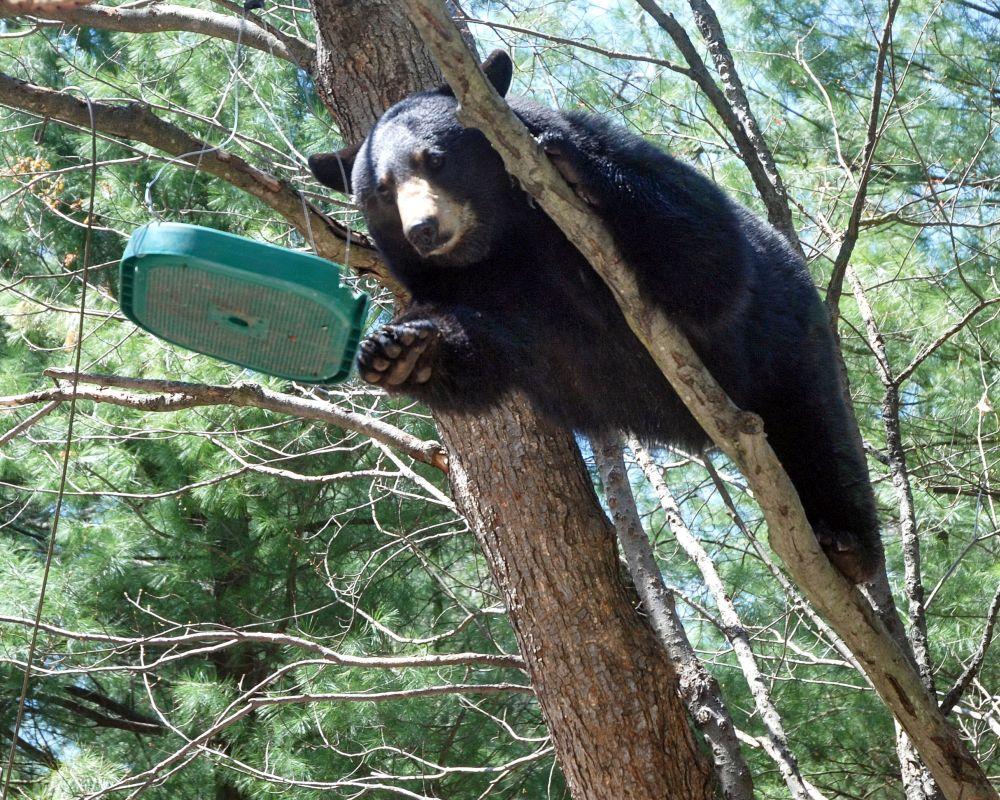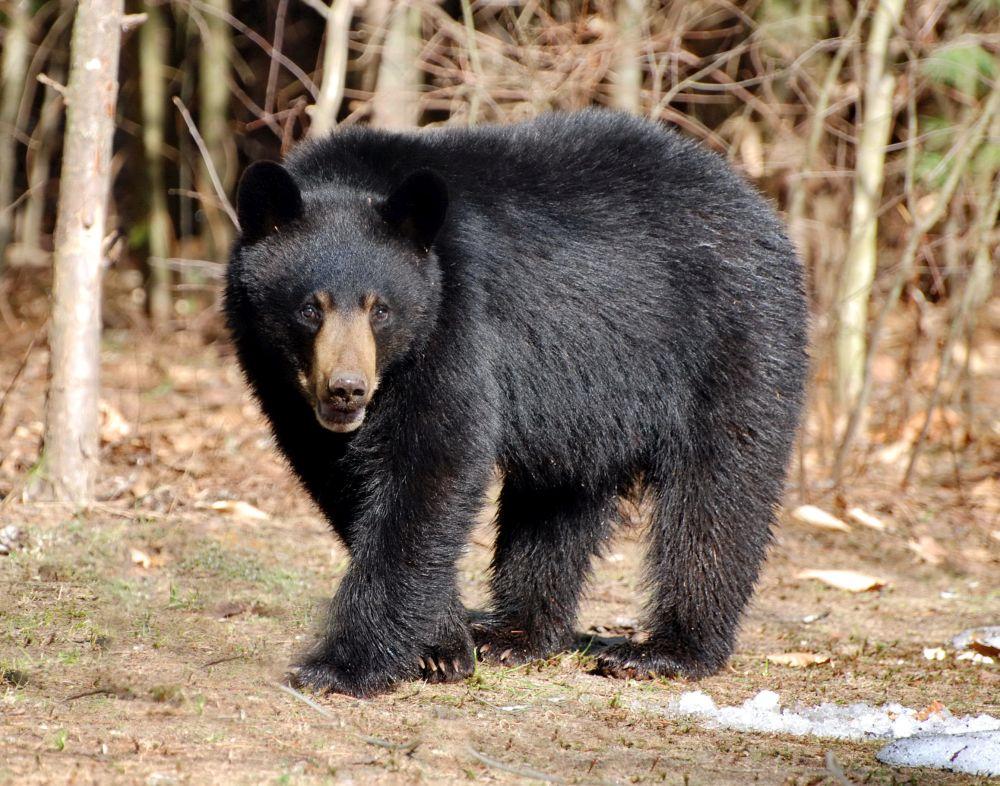What lessons might we learn from controversial relocation of Hanover bears?
- Tags:
- Wildlife

Black bear sightings spike annually in early June when breeding season returns. Photos: Sheri Tucker
They’re out there – somewhere.
Three yearling bears, brothers, recently relocated from a Hanover neighborhood where they first learned to forage from dumpsters, trash cans and birdfeeders are now exploring a tract of forestland in rural northern NH. There are an additional estimated 6,097 other bears out there too – including their mamma.
Most NH bears do NOT enter homes or – as Hanover Deputy Fire Chief Michael Hinsley described in a Valley News article - go on porches, force through doors and sit in chairs around backyard fire pits. Imagine that? You have to admit - if the bears roasted marshmallows to make S’mores, wouldn’t that be “adorable?”
See? That’s our problem: we want backyard bears and our backyards too. The latter part becomes a problem when wildlife guests overstay their welcome or invite themselves inside. Hanover Town Manager Julia Griffin described in a May 23 Valley News story how Hanover residents developed a love/hate relationship with bears, wanting to see them and take care of them but creating a hazard in the process when the bears were emboldened, no longer threatened by humans, and seeking food inside homes.
Typically entering a home is “game over,” the “red line” that defines when a nuisance bear becomes a dangerous hazard. NH wildlife authorities eliminated more than a dozen bears last year and the number was more than twenty in Vermont. As populations of both people and bears increase, its likely more human and wildlife conflicts will occur.
We have an opportunity now to set aside un-fragmented forest habitat before we lose it. The core mission of NH’s land conservation community, including land trusts and landowners like the Forest Society, includes actively working to protect and manage adequate areas of intact forest for wildlife habitat and connectivity via wildlife travel corridors.
The long term solution is to support local land conservation efforts. At 84% forested, New Hampshire is the second-most forested state by land area in the entire US. Black bear expert, Ben Kilham explains how black bears are superbly adapted to living in Northern forests. Black bears are particularly well-adapted for digging, climbing and foraging over vast territories. A male black bear boars ranges over 25 to 50 square miles annually. Female sows typically inhabit smaller territories of 5 to 10 square miles.
While continued development of open space – farms and forests - seems inevitable as human population increases, intentional and thoughtful land conservation is not similarly guaranteed. Green infrastructure is essential to black bears.
“We have met the enemy ... and he is us.”
At first it might seem odd that the fate of four badly-behaving Hanover bears would explode across the internet. Yet a petition to save their lives garnered more than 10,000 signatures in a matter of days. It quickly became a red hot story and the emotional debate ensued around water coolers and dinner tables.
The response seemed almost a matter of collective guilt in recognition that people were responsible for creating the situation. Nearly everyone agreed it was less of a “bear problem” and more a “people problem.”
Yet there was little agreement about which people were most to blame - local residents, out-of-staters, politicians, unrepentant bird-feeders, state wildlife officials or even those posting photos of bear encounters on social media. “Adorable” backyard bear photos are as yummy to people as black oil sunflower seeds are to the bears.
Why does this keep happening?
When bears supplement natural foods with garbage, pet food or birdseed, they produce larger litters of cubs. Typically sows birth two to three cubs. Fed bears routinely birth three, four or even five cubs. More cubs are harder to sustain so high-risk behavior, seeking higher calorie artificial foods becomes a self-perpetuating cycle. The Hanover bears are reminiscent of the celebrated “Jackson Five” breaking into homes and cabins two years ago in the White Mountain community of Jackson. The Jackson bears were also being intentionally fed by local residents.
The challenge for biologists is trying to change behavior of females accustomed to raising cubs in more populated areas. Of the still-wandering Hanover momma bear, N.H. Fish and Game bear biologist, Andrew Timmins says “what we don’t want is her staying in that area pumping (more) cubs into it.”

Solutions
How can NH residents help break the cycle of bear dependence on human food source and reliance on more developed neighborhoods for foraging?
Most people agree the best way to change bear behavior is to change human behavior. If people wish to have occasional opportunities to see bears, it requires a responsibility to behave better in our own backyards.
A central tenet of the “Something’s Bruin” public education campaign at N.H. Fish and Game is “A fed bear is a dead bear.” Bears are most active from early April through late October. During the warmer months, follow N.H. Fish and Game guidelines to eliminate bear attractants:
Take down birdfeeders.
Secure trash cans inside a closed garage
Keep pet foods and barbeque grills off the deck or inside a garage
Protect domestic bee hives and chicken coops with electric fences.
Bears that frequent developed neighborhoods, climbing fences and crossing backyards, are at higher risk of being struck by cars. Confrontations with dogs or homeowners can separate sows from cubs. Bears seek refuge by climbing backyard trees which can attract more unwanted attention; see synonyms at even more social media photos.
Bears are particularly hungry now - at the outset of their June breeding season when natural foods remain scarce. One of my neighbors just posted Facebook photos of several wooden bluebird nest boxes smashed-open by a hungry bear in search of tiny bluebird eggs. By comparison, an unsecured restaurant dumpster seems like a buffet!
Late summer and autumn natural food sources - fruits and nuts - are more plentiful. The annual availability of highly nutritious oak acorns and beechnuts, so-called “hard mast” crops, influence bear behavior in autumn. Good forestry plays an important role in providing these wildlife food sources across the larger landscape.
In years of natural oak acorn and beechnut scarcity, forest bears leave the woods to access sunny landscapes providing grapes, cherries, berries, apples, sweet corn or other domestic crops. In years of late summer and autumn acorn and beechnut scarcity, forest-dwelling black bears risk more contact with humans living on valley farms or in rural villages and more heavily developed suburbs.

Bear expert, Ben Kilham describes how in June, breeding sows drive off yearling cubs before leaving their core home range accompanied by a larger, protective male boar. Sows take advantage of the rare opportunity to visit new real estate, scoping out food resources of adjacent territories occupied by unrelated resident females. In matriarchal bear society, Kilham has documented a practice he describes as “reciprocal altruism,” food sharing between unrelated females occupying adjacent territories. When a particular food source becomes scarce, females more readily share territory.
Sharing habitat while NOT sharing human foods that promote bad bear habits will remain key to the future viability of NH black bear populations near developed regions of the state. Will residents demonstrate a capacity to educate ourselves about black bears and to learn from past mistakes?
